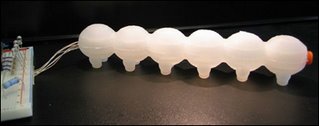 Tufts University biologists and engineers have launched an initiative to build robots with pliable parts — from the body down to the electronic components and wiring.
Tufts University biologists and engineers have launched an initiative to build robots with pliable parts — from the body down to the electronic components and wiring.The soft-sided robots will be able to collapse into small packages and spring back to form as well as climb textured surfaces and burrow into confined spaces.
Flexible robots could do everything from explore inside a person's body to help doctors make a medical diagnosis, to examine industrial pipelines for damage. They could also be used to climb through hazardous zones such as inside a nuclear reactor or minefield, or repair delicate solar panels on space vehicles.
"In the next year or so we will be building machines that are squishy and can crawl," said Barry Trimmer, who, with David Kaplan, co-directs the Biomimetic Technologies for Soft-bodied Robots project.
Trimmer has spent years studying the nervous systems of caterpillars and silkworms to better understand how the creatures control their undulating motions with very simple brains.
He has identified individual cells in the brain responsible for certain movements.
Because the animals are flexible and lack skeletons, their movement is less limited than that of animals with skeletal systems. The human elbow, for example, can only bend in two directions.
Many rigid robots have similar kinds of joints.
But caterpillars can move in many directions, and don't need much of neural power to do it. Their muscles respond to simple signals from the brain, yet have the ability to twist and contort to move up a tree branch or reach under a leaf.
The idea is to build a robotic control system that mimics the nervous system and muscle power of the caterpillar.
Kaplan's department will conduct research on the soft materials meant to make up the body and electronics. Kaplan is applying genetic engineering and nanotechnology to produce flexible materials as tough as spider silk.
In the end, the team hopes to create "A robot that you can pick up and crumple into a ball in your hand, let it go, and watch it walk away," said Trimmer.
Having robots that lack rigid parts is a goal shared by other researchers, said professor Ian Walker of Clemson University in Clemson, S.C. But a lack of metal could mean a lack of power.
"Other groups, including our own in developing 'trunk and tentacle' robots, have aimed at producing completely soft robots, but have had to settle for having at least some rigid parts," he said.
"It will be interesting to see if they can get enough strength from the materials and components they plan to use. This has been a key issue."
No comments:
Post a Comment